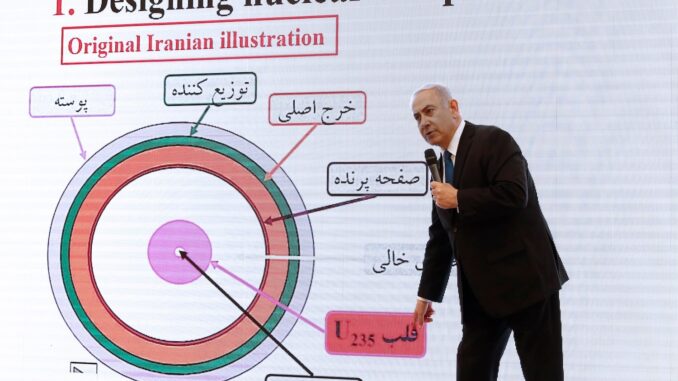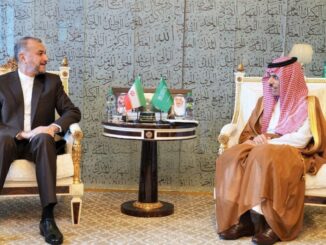
The history of other countries’ weapons programs shows that Tehran could complete and deploy a missile-deliverable warhead in a matter of months.
Earlier this summer, U.S. Secretary of State Antony Blinken revealed that Iran could produce enough weapons-grade uranium to make its first nuclear bomb in just one or two weeks. That’s pretty frightening. But now some experts argue that Tehran would still need up to one year to fashion this material into a working weapon and even longer—perhaps a year or two—to fully build a missile-deliverable warhead.
You should be skeptical. A look at other countries’ nuclear bomb-building efforts suggests that these projections are wrong. For a missile-deliverable weapon, Iran needs to perfect nonnuclear, high-explosive-related components to compress the weapons-grade uranium and produce a nuclear yield. These nonnuclear components also need to be small and light enough to be carried on ballistic missiles.
Iran’s first nuclear weapon will almost certainly be missile-deliverable because that is the design that the country was working on more than 20 years ago. Tehran could fully produce and deploy this weapon in a matter of months. It would not take years. And Iran certainly could produce all the nonnuclear warhead components that it needs for this device before it fuels it with any highly enriched uranium.
The estimate that Blinken gave in July is also too rosy: Iran is not a week away from having enough weapons-grade uranium for a single bomb, but rather—according to our own calculations—enough for four (and enough for an additional six weapons in just eight more weeks).
That matters for those who believe that Iran would never proceed unless it could build several weapons at once. It could.
How quickly, then, could Iran convert its weapons-grade uranium into actual weapons?
If the country is under pressure, Tehran could do this much more quickly than most people think. Historically, nine of the world’s 10 current and former nuclear weapons states were at peace when they built their first nuclear warheads. Their technicians slowly and methodically tested each weapon component to assure their weapon would produce the expected yield when detonated. As a result, their weaponization programs were unhurried and deliberate.
Iran’s position is quite different. Israeli Prime Minister Benjamin Netanyahu’s threat to attack Iran’s nuclear weapons infrastructure places enormous pressure on Tehran to make its bombs quickly if it wants to cross the nuclear threshold.
Unfortunately, unlike the nuclear weapons states that required years to accumulate enough weapons-grade plutonium or uranium for their first bombs, Iran is already very close to reaching the threshold of the nuclear material that it needs for this purpose. Iran’s example is unusual. It’s not, however, unprecedented.
In the early 1940s, the United States was at war and developing its first nuclear weapons. Its service members were dying in large numbers every day. Washington was under tremendous pressure to produce its first nuclear weapons in the hope that they would help end the war. The Manhattan Project cost more than $30 billion in today’s dollars. (Given how far along Iran is with its own nuclear program, its forward costs to build its nuclear arsenal would be a small fraction of that number.) This pressure pushed the United States to complete every step as quickly as possible, even though no one knew for sure if an effective nuclear weapon could be made.
Some, for example, have claimed that just converting uranium hexafluoride into the required metallic shapes could take up to six months. U.S. experience in World War II, however, shows that this estimate is wrong. The weapon detonated over Hiroshima was a gun-type device that needed more than 60 kilograms (132 pounds) of highly enriched uranium—several times what Iran’s more modern weapons would require. The nonnuclear components needed to assemble this material and detonate it were completed well in advance of when the Manhattan Project had produced sufficient highly enriched uranium.
Records on the project’s history that have been declassified and released in the years since show that even though highly enriched uranium production for the Hiroshima weapon continued until July 15, 1945, the final metallic highly enriched uranium components were completed by July 24, 1945, only nine days later. They were then quickly flown to the island of Tinian, where they were used to bomb Hiroshima on Aug. 6, 1945.
Another misconception that experts now have is that making nuclear weapons is so difficult that there are likely to be major losses of weapons-grade uranium or plutonium during the chemical process of converting the uranium from hexafluoride to metal and then physically casting and machining the metal into the required shape. Experts argue that these losses, in turn, would require the production of significantly more enriched uranium than is required for a weapon, adding more time to the project. Some of these estimated wastage claims have been as high as 50 percent.
Given that weapons-grade uranium and plutonium are more valuable than gold, the idea that Iran or any country would allow this much material to be lost is bizarre. In the Manhattan Project, researchers estimate that no more than 6 percent of the highly enriched uranium was likely lost, and this is an upper bound. In the early 1990s, after South Africa dismantled its nuclear weapons program—which also relied on highly enriched uranium—an accounting of the program showed that only about 1.2 percent of the highly enriched uranium had been lost.
Certainly, what is most important in calculating how soon Iran could make its first bombs is the fact that Tehran need not wait until it has the uranium to start work on the bomb’s nonnuclear components.
As long ago as 1946, it was clear that producing the nuclear material for a weapon and completing the nonnuclear weapon components could be done in parallel.
On this point, William Penney—who fulfilled the role of J. Robert Oppenheimer in the British nuclear weapons program—was clear. As he noted then, “the ordnance part, that is, the manufacture and assembly of the components causing the explosion of the active material … the work could be begun and completed without the need to use fissile material at any stage.” Thus, the nonnuclear components for the Hiroshima weapon were completed well before the highly enriched uranium components were ready.
The next question, assuming Iran had produced its first nuclear weapon, is: how deliverable would it be? Many still believe that any country’s first nuclear weapon would resemble the United States’ Fat Man bomb design that was tested at the Trinity site in New Mexico on July 16, 1945, and detonated over Nagasaki on Aug. 9, 1945. This is not true.
Almost every new nuclear weapons aspirant has used designs much more advanced than that of the Fat Man, which was heavy and huge—five feet in diameter and about five tons. This is far too heavy and large to be deliverable by a ballistic missile, and Iran knows this.
Since the United States was building the very first nuclear weapons ever, the Fat Man design was very conservative. As a result, it did not employ a technique called levitation. Levitated bombs place an air gap surrounding the nuclear core. This allows the blast wave from the nonnuclear explosives in the weapon to gain speed and compress the nuclear core more efficiently. The use of levitation is obvious to anyone designing a nuclear weapon.
U.S. nuclear weapon designer Ted Taylor first explained the principle behind levitation: “When you hammer a nail … do you put the hammer on the nail and push?” The answer should be obvious—to get momentum and inertia on the nail head, you need to swing your hammer. It’s just the same when compressing a sphere of plutonium or uranium.
The first nuclear weapons built by Britain, France, and China all employed levitation. The Soviet Union’s bombs didn’t because Moscow simply copied the United States’ conservative Fat Man design. But the new technique allowed the other countries’ early nuclear weapons designs to be much smaller and lighter than Fat Man.
The French AN-52 tactical bomb, which employed this technique, was only two feet in diameter and weighed only about 1,000 pounds, yet its maximum yield was 35 kilotons, significantly more than the 21 kiloton yield of Fat Man. Even the Swedes, who pursued a nuclear program but eventually decided against building weapons, had a workable first nuclear weapons design in 1955 that weighed about the same and was less than 14 inches in diameter.
The nuclear weapons design Iran had in 2003, which was revealed when Israel captured Iran’s nuclear archive documents in 2018, suggests that Tehran’s weapons designs were already similarly advanced two decades ago. That design employed a levitated pit, had other characteristics similar to France’s AN-52, and was about two feet in diameter. A nuclear warhead of that size could be carried on an Iranian Shahab-3 ballistic missile. This is clear evidence that Iran was seeking a ballistic missile-deliverable warhead from the start.
Once the United States had produced the design for its Nagasaki weapon, it took only five months to build and test the weapon at Trinity. The International Atomic Energy Agency determined in 2015 that Iran already had a compacted lightweight weapon design provided by a Russian nuclear weapons designer. This was the Iranian weapon design shown in the archive Israel obtained, and among other features, it had “multipoint initiation”—an advanced design technique.
Iran had already done preliminary testing of this design more than 20 years ago. As a result, Tehran is now in a position to produce and deploy a missile-deliverable weapon in a matter of months, not years.
Of course, no one knows precisely when Iran will acquire nuclear weapons. However, the U.S. Office of the Director of National Intelligence has determined that Iran has “undertaken activities that better position it to produce a nuclear device, if it chooses to do so.”
That—and history—suggest that Iran could have a ballistic missile-deliverable nuclear weapon much faster than many experts assume
We give you energy news and help invest in energy projects too, click here to learn more





